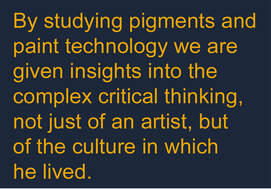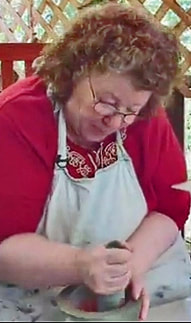About Native Paint Revealed

Native Paint Revealed is the result of my asking a question 26 years ago that no one could answer: what made the blue and green pigments used by NW Coast Indigenous people?
What began as a simple question turned into a full time passion and job researching, experimenting, educating and writing about color use, and the traditional materials, tools and techniques of NW Coast paint technology.
After years of research I was finally able to correctly identify (through microscopic technologies) and reintroduce vivianite, a blue iron phosphate mineral, to the NW Coast traditional palette. My research into the use of vivianite has demonstrated how and why this material became so significant to NWC cultures that it was only used for specific types of ritual and ceremonial objects (read about this under publications: "Revealing Blue on the Northern Northwest Coast).
Several years ago I was asked to take a look at three pigment grinding stones and identify the pigment residues on them. My identification of celadonite on a 4,000 year old pigment grinding stone lead to the discovery that the Coast Salish were the first people in history to use celadonite as a pigment. I am currently working on identifying and documenting the use of another pigment, chlorite, and determining the use of cinnabar on NWC painted objects.
Working with museums, conservators, collectors, artists and scholars, and others, I identify the materials, tools and techniques used in the composition of artifacts. Through pigment analysis I provide information about where a piece was made, its approximate date of manufacture, the environment in which it was made, identify sibling pieces, and potentially ascribe authorship.
Through private tutorials, mentoring, lectures, workshops and writing I am able to share everything I've learned over the past 26 years. I teach how to source and use materials to make traditional paint and binders, to make traditional style paint brushes, prepare surfaces for painting, and teach the various methods of paint application used by ancient people.
My objective with my research and this website, is to provide information and services that will help piece back together important aspects of NW Coast traditions and life that have, until now, been overlooked and unknown.
My quest for answers has led me on an incredible journey of discovering new information about the cultures of the NW Coast, their lifestyles, cosmologies and worldviews. It has opened new doors of research and to better understanding the sophisticated and complex cultures of the NW Coast. I am working on a book about the evolution and history of color use and the specific materials, tools and methods used by NWC cultures for painted objects.
If you are interested in studying or interning with me, or in developing a thesis from my research, please contact me at [email protected].
What began as a simple question turned into a full time passion and job researching, experimenting, educating and writing about color use, and the traditional materials, tools and techniques of NW Coast paint technology.
After years of research I was finally able to correctly identify (through microscopic technologies) and reintroduce vivianite, a blue iron phosphate mineral, to the NW Coast traditional palette. My research into the use of vivianite has demonstrated how and why this material became so significant to NWC cultures that it was only used for specific types of ritual and ceremonial objects (read about this under publications: "Revealing Blue on the Northern Northwest Coast).
Several years ago I was asked to take a look at three pigment grinding stones and identify the pigment residues on them. My identification of celadonite on a 4,000 year old pigment grinding stone lead to the discovery that the Coast Salish were the first people in history to use celadonite as a pigment. I am currently working on identifying and documenting the use of another pigment, chlorite, and determining the use of cinnabar on NWC painted objects.
Working with museums, conservators, collectors, artists and scholars, and others, I identify the materials, tools and techniques used in the composition of artifacts. Through pigment analysis I provide information about where a piece was made, its approximate date of manufacture, the environment in which it was made, identify sibling pieces, and potentially ascribe authorship.
Through private tutorials, mentoring, lectures, workshops and writing I am able to share everything I've learned over the past 26 years. I teach how to source and use materials to make traditional paint and binders, to make traditional style paint brushes, prepare surfaces for painting, and teach the various methods of paint application used by ancient people.
My objective with my research and this website, is to provide information and services that will help piece back together important aspects of NW Coast traditions and life that have, until now, been overlooked and unknown.
My quest for answers has led me on an incredible journey of discovering new information about the cultures of the NW Coast, their lifestyles, cosmologies and worldviews. It has opened new doors of research and to better understanding the sophisticated and complex cultures of the NW Coast. I am working on a book about the evolution and history of color use and the specific materials, tools and methods used by NWC cultures for painted objects.
If you are interested in studying or interning with me, or in developing a thesis from my research, please contact me at [email protected].

Acknowledged by many museums, conservators and scholars as the authority on Northwest Coast Indigenous color use, and traditional pigment and paint technology, Melonie Ancheta is the founder and head researcher of Native Paint Revealed. For more than 25 years, Ancheta has conducted analysis of pigments, and researched the significance of traditional colors, and the traditional materials, tools and techniques of NW Coast Indigenous paint technology. Ancheta works with museums, conservators, collectors, artists and historians to identify pigments on NW Coast artifacts, She also provides restoration and replication of artifacts for NW Coast Master Artists when a piece is damaged or destroyed. An ardent educator about NW Coast Indigenous art and culture, and pigment and paint technology, Ancheta teaches classes, and does guest lectures and workshops.
In the process of researching NW Coast paint technologies, Ancheta has confirmed the use of celadonite, a green pigment, on the NW Coast for at least 4,000 years. She is the first person to identify and study the use and behaviors of the blue pigment, vivianite, as used by NW Coast Indigenous cultures. Currently she is working on a book about traditional NW Coast color use, and pigment and paint technology, and researching the use of cinnabar and chlorite by NWC people.
Ancheta’s groundbreaking work is opening new fields of study within Northwest Coast Indigenous studies as well as in the disciplines of materials and cultural studies in general. Her work is assisting in determining place of origin for artifacts, provenance, identification of sibling artifacts and authorship. It is also helping develop better conservation and storage methods for artifacts based on the materials from which they are made.
A contributing author to A Totem Pole History: The work of Lummi carver Joe Hillaire, Ancheta’s publications also include:
•“Coloring the Native Northwest Coast”, published in the Spring 2016 issue of the Smithsonian’s National Museum of the American Indian Magazine, American Indian
•“Celadonite and Vivianite: Revealing Green and Blue Pigments on the Northwest Coast”, presented at the Western Association for Art Conservation Conference
•“Coloring the Ancient: Northwest Coast Native Pigments”, given at the Northwest Anthropology and Archaeology conference
•“Revealing Blue on the Northern Northwest Coast”, published January 2020 by UCLA’s American Indian Studies Department in the American Indian Culture and Research Journal (DOI 10.17953/aicrj.43.1.ancheta). This monograph is an in depth discussion of the blue pigment, vivianite, and its use and enormous significance to NW Coast Native cultures.
Ancheta is also the founder of Pigments Revealed, an organization committed to promoting research, study and restoration of knowledge about natural pigments by creating strong international, interdisciplinary relationships between researchers, scholars and artists for the purpose of sharing knowledge and expertise about natural pigments, building alliances for collaborative work, and developing research and education opportunities.
In the process of researching NW Coast paint technologies, Ancheta has confirmed the use of celadonite, a green pigment, on the NW Coast for at least 4,000 years. She is the first person to identify and study the use and behaviors of the blue pigment, vivianite, as used by NW Coast Indigenous cultures. Currently she is working on a book about traditional NW Coast color use, and pigment and paint technology, and researching the use of cinnabar and chlorite by NWC people.
Ancheta’s groundbreaking work is opening new fields of study within Northwest Coast Indigenous studies as well as in the disciplines of materials and cultural studies in general. Her work is assisting in determining place of origin for artifacts, provenance, identification of sibling artifacts and authorship. It is also helping develop better conservation and storage methods for artifacts based on the materials from which they are made.
A contributing author to A Totem Pole History: The work of Lummi carver Joe Hillaire, Ancheta’s publications also include:
•“Coloring the Native Northwest Coast”, published in the Spring 2016 issue of the Smithsonian’s National Museum of the American Indian Magazine, American Indian
•“Celadonite and Vivianite: Revealing Green and Blue Pigments on the Northwest Coast”, presented at the Western Association for Art Conservation Conference
•“Coloring the Ancient: Northwest Coast Native Pigments”, given at the Northwest Anthropology and Archaeology conference
•“Revealing Blue on the Northern Northwest Coast”, published January 2020 by UCLA’s American Indian Studies Department in the American Indian Culture and Research Journal (DOI 10.17953/aicrj.43.1.ancheta). This monograph is an in depth discussion of the blue pigment, vivianite, and its use and enormous significance to NW Coast Native cultures.
Ancheta is also the founder of Pigments Revealed, an organization committed to promoting research, study and restoration of knowledge about natural pigments by creating strong international, interdisciplinary relationships between researchers, scholars and artists for the purpose of sharing knowledge and expertise about natural pigments, building alliances for collaborative work, and developing research and education opportunities.
cv_1.2020.docx For CV, please follow this link.
